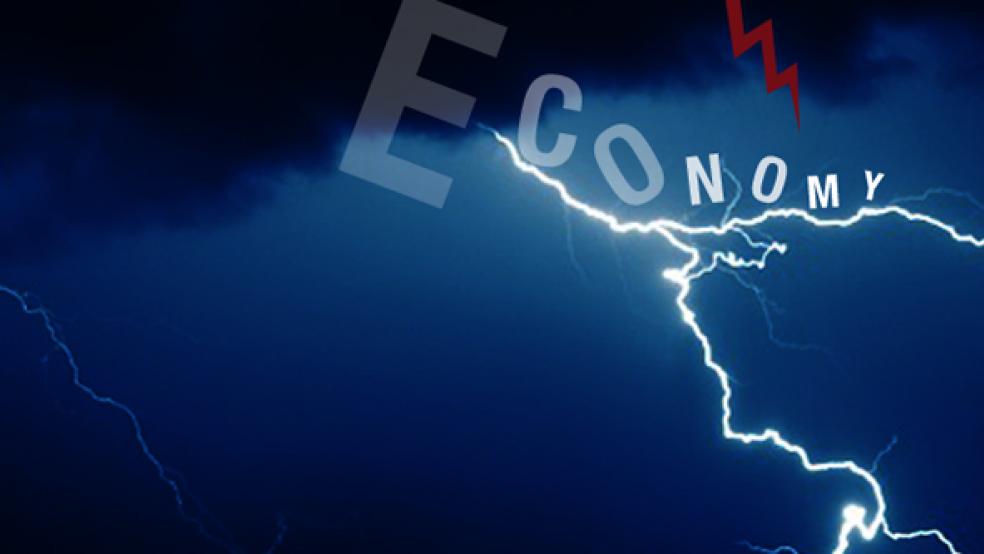It’s now all over but the debt-ceiling spinning. In return for $2.1 trillion in prescribed and to-be-determined spending cuts, economic Armageddon will have to wait. That may disappoint some members of Congress, who actually seemed eager for financial end times (their districts presumably would be raptured out of harm’s way). But the rest of us should be relieved that Congress, in its wisdom, found a way not to shoot the economy in the head.
That’s not to say, however, that there will be no economic consequences. The world did not fail to note that America’s deliberative bodies spent six months debating whether to renege on the nation’s promises and wantonly discard one of its most important global assets—its triple-A credit rating. In addition to turning klieg lights on Washington’s dysfunction, the spectacle confirmed the power of a conservative minority to force its flakey economics on the rest of us, even to the point of recession. Whatever this has done to the political calculus of 2012, it has not made Americans more financially secure.
So get ready for the economic blowback. Here’s what could happen.
U.S. debt will probably be downgraded anyway. Default has been avoided, but default was never the only condition that could trigger a downgrade. Rating agencies (and creditors), after all, aren’t interested solely in whether a borrower is making payments. They also care whether it will continue to do so.
While America’s ability to service its debt was never at issue, the past few months cast considerable doubt on its seriousness about doing so. Consider that all but one of the Republican candidates for the U.S. Presidency--two them, Michele Bachmann and Ron Paul, sitting members of Congress--declared that they would not vote for the debt ceiling compromise. This comes only a few months after Congress approved a budget that made an increase in the debt ceiling essential to paying our bills. “To come at it now after the budget has been passed is like getting your Visa bill and calling up the company to say, ‘Actually we don't want to buy all that stuff we bought,’ wrote Fareed Zakaria in his CNN blog. “That’s not how it works.”
The deathwatch for the Treasury’s Triple-A rating has focused mainly on Standard & Poors, the most hawkish of the three major rating agencies. (Moody’s and Fitch have merely put U.S. debt on the equivalent of probation.) S&P warned of a 50 percent chance of downgrade in the next few months, even without a default. John Chambers, chairman of the company’s sovereign rating committee, hinted what might keep him from pulling the trap door, saying that $4 trillion in deficit reduction would be a “good down payment” on fiscal rehab. Yesterday’s compromise deal falls well short of that.
If S&P does downgrade, it won’t be the first. The small credit agency Egan Jones downgraded U.S. debt two weeks ago, even though it assumed that a debt ceiling deal would eventually pass. “We are taking a negative action not based on the delay in raising the debt ceiling but rather on our concern about the high level of debt to GDP, now in excess of 100 percent,” the company explained. Egan Jones’s ratio compares the value of all future and current liabilities to an estimated present value of GDP; the analogous ratio in Canada, by way of comparison, is just 35 percent. Other downgrades are more emotional. “I am downgrading U.S. Treasury debt from AAA to AA+ this morning,” wrote economist Ed Yardeni last Monday. “Admittedly, Yardeni Research isn’t a credit rating agency. However, this is a free country, and I am entitled to express my opinion. A plague on both our Houses of Congress.”
And even if S&P chooses not to downgrade, the psychological damage has been done, Zakaria writes. “From now on, every time the debt ceiling needs to be raised, the world will wonder: Will the U.S. stand by its promises or will it break them?”
Growth will be weaker. Global stock markets initially staged a relief rally on news of the compromise, but the Dow and the S&P both lost ground by the closing bell on Monday.. The compromise deal would phase spending cuts in over 10 years, avoiding a cold turkey pullback that could shock the economy immediately back into recession.
The spending cuts certainly make the recovery more precarious, however. Before the debt ceiling debate began, reasonable policy makers could argue over whether the best course for recovery was more stimulus, to goose consumer demand, or more austerity, to cut the deficit. The terms of the debt ceiling debate, however, have taken fiscal stimulus entirely out of the picture.
It’s hard to understand why it’s a good idea to throw away those to levers at this point. As the federal government retrenches, “Unemployment will be higher than it would have been otherwise, Mohamed El-Erian, chief executive of the bond investment firm Pimco, said Sunday on ABC. “Growth will be lower than it would be otherwise…Withdrawing more spending at this stage will make [an already weak economy] even weaker.” The Commerce Dept. estimates that spending cuts at the state level have taken 1.2 percent out of GDP growth already.
That doesn’t leave much growth to spare. The economy grew a pathetic 1.3 percent in the second quarter after inching ahead a nearly invisible 0.4 percent for the year’s first three months. No wonder consumer confidence, as reported by the University of Michigan sentiment index, dropped to a level last seen at the bottom of the recession in 2009.
And then there is the effect of the likely downgrade of Treasuries. The effect would be modest at first, reflecting the lack of liquid alternatives. But in the next few years, predicts Terry Belton, global head of fixed income for JPMorgan, a drop to AA could push up the rate the Treasury has to pay investors by 0.6 to 0.7 percentage points. That could increase U.S. borrowing costs by $100 billion a year, Belton calculates. Think about it: The self-inflicted damage to our reputation effectively undoes the $917 billion in 10-year spending cuts so painfully negotiated for the first phase of the debt ceiling compromise.
In short, all that Washington accomplished in this unseemly spectacle was to raise serious doubts about the country’s creditworthiness, throw more obstacles in the path of economic recovery, and, so far, probably fail to narrow the deficit. Writing while the details of the compromise were still being worked out, Berkeley economist Brad DeLong’s delivered his initial verdict on the broad outline of the deal, a view shared by a number of economists outside the Republican pale. “I suspect that come Tuesday I will be forecasting a double-dip. Horrible for the economy. Horrible for America. Horrible for the world.”
More on the debt-ceiling deal from The Fiscal Times:
Angry Responses to Debt Deal
Mad as Hell? Don’t Take It Anymore!






